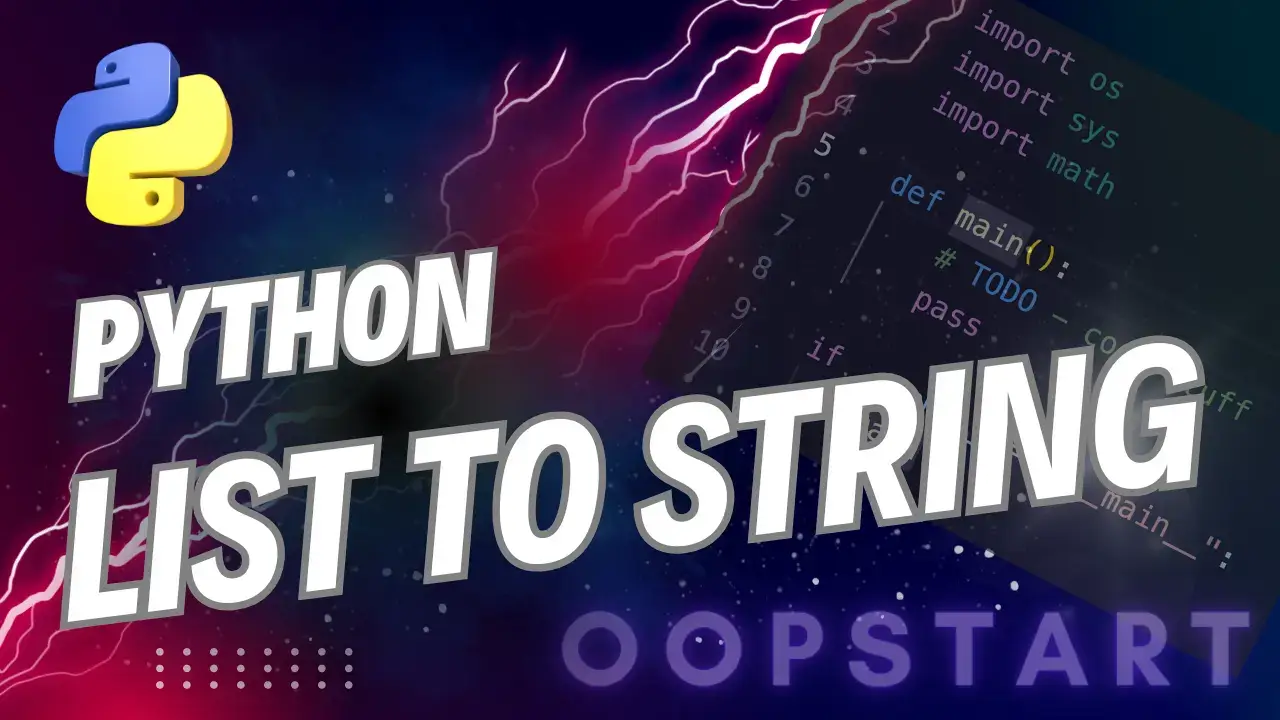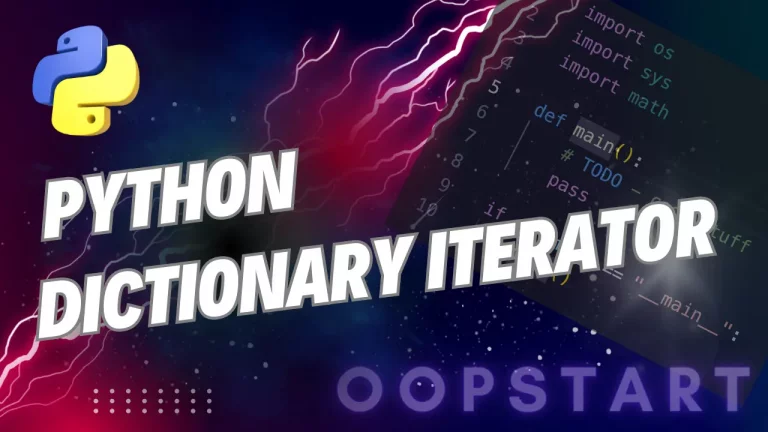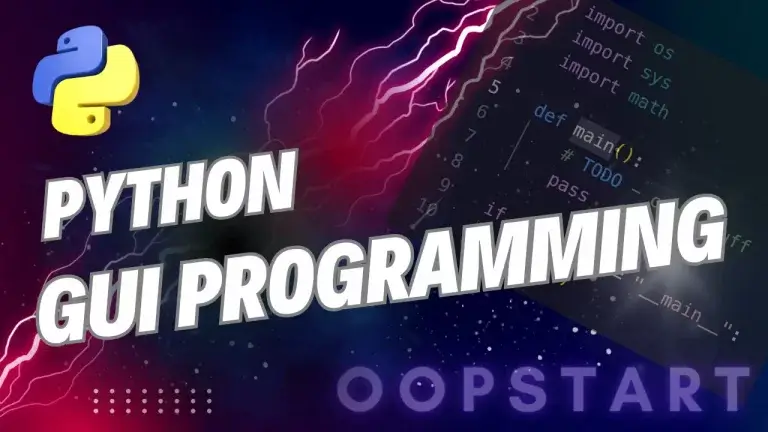Python List to String: Ultimate Guide
Converting a Python list to string is another common task. Whether you’re preparing data for output, transforming it for an API call, or simply manipulating text, understanding how to convert a list into a string is essential.
In Python, lists are a flexible and powerful data structure, but they often need to be formatted or converted into a single string, especially when working with data streams, files, or web applications.
By the end of this guide, you’ll be able to convert any Python list to a string quickly and efficiently.
Table of Contents
Why Convert a Python List to a String?
There are many situations where converting a Python list to a string is necessary:
- Displaying Data: When preparing data for output or displaying it in user-friendly formats, it’s often easier to work with a string than a list.
- Storing Data: Lists are complex objects, and sometimes you need to store or save them as simple strings in a file or database.
- Working with APIs: Many APIs require data to be sent as strings, so converting lists into strings is essential.
- Building Queries: When constructing SQL queries or URL parameters, you might need to convert lists into a formatted string.
Methods to Convert a Python List to a String
1. Using the join() Method
The most common and efficient way to convert a list to a string in Python is by using the join() method. The join() method concatenates all elements of an iterable (like a list) into a single string, using a specified separator.
Syntax:
string = separator.join(iterable)
separator: The string that separates each element in the resulting string.iterable: The list (or any iterable) to be converted.
Example 1: Converting a List of Strings
words = ["Python", "is", "fun"]
result = " ".join(words)
print(result) # Output: "Python is fun"
In this example, the list ["Python", "is", "fun"] is joined using a space " " as the separator, resulting in the string "Python is fun".
Example 2: Converting a List of Characters
chars = ['H', 'e', 'l', 'l', 'o']
result = "".join(chars)
print(result) # Output: "Hello"
Here, the list of characters is joined without a separator, resulting in the string "Hello".
2. Using a For Loop
Another method to convert a list to a string is by using a for loop. While this approach is not as efficient as join(), it can be useful for more complex scenarios, such as when you need to perform additional operations on each element.
Example:
numbers = [1, 2, 3, 4]
result = ""
for num in numbers:
result += str(num) + " "
print(result.strip()) # Output: "1 2 3 4"
In this example, each element in the list is converted to a string using str() and concatenated to the result string, followed by a space. The final string is stripped of the trailing space using strip().
3. List Comprehension with join()
List comprehension can be combined with join() to provide a concise and efficient way to convert a list to a string. This is especially useful when the list contains elements that need to be converted to strings first.
Example:
mixed_list = [1, 2, "Python", 4]
result = " ".join([str(x) for x in mixed_list])
print(result) # Output: "1 2 Python 4"
Here, the list comprehension [str(x) for x in mixed_list] ensures that all elements are converted to strings before being joined with a space separator.
Handling Lists with Mixed Data Types
Lists in Python can contain a mix of data types, such as strings, integers, floats, and more. In such cases, you need to convert each element to a string before joining them. Using str() on each element ensures that non-string elements like integers and floats are properly converted.
Example:
mixed_list = ["The answer is", 42, "and pi is", 3.14]
result = " ".join([str(x) for x in mixed_list])
print(result) # Output: "The answer is 42 and pi is 3.14"
In this case, both integers (42) and floats (3.14) are converted to strings before joining the list into a single string.
Converting a List of Numbers to a String
When you have a list of numbers, you can use the same methods as before, but you must explicitly convert the numbers to strings before joining them.
Example:
numbers = [10, 20, 30, 40]
result = ", ".join(map(str, numbers))
print(result) # Output: "10, 20, 30, 40"
Here, map(str, numbers) converts each number to a string, and join() combines them with a comma separator.
Special Cases: Nested Lists
When working with nested lists, where the list contains other lists, you need to handle each sublist individually before converting the entire list to a string.
Example:
nested_list = [["Python", "is"], ["fun", "and"], ["powerful"]]
result = " | ".join([" ".join(sublist) for sublist in nested_list])
print(result) # Output: "Python is | fun and | powerful"
In this example, we first join each sublist into a string, then combine the resulting strings with " | " as the separator.
Performance Considerations
The join() method is the most efficient way to convert a list to a string in Python. It is significantly faster than using a for loop to concatenate strings, especially for large lists. This is because join() creates the final string in one go, while a for loop repeatedly creates new strings in memory, which is slower.
Example of Performance Difference:
import time
large_list = ["item"] * 1000000 # A list with 1 million elements
# Using join()
start = time.time()
result = "".join(large_list)
end = time.time()
print(f"Time with join(): {end - start}")
# Using a for loop
start = time.time()
result = ""
for item in large_list:
result += item
end = time.time()
print(f"Time with for loop: {end - start}")
You’ll find that using join() is significantly faster, especially for larger lists.
Common Pitfalls and How to Avoid Them
1. Forgetting to Convert Non-String Elements
If your list contains elements that are not strings (such as integers or floats), you’ll encounter a TypeError when trying to join them directly.
Example:
numbers = [1, 2, 3]
# This will raise an error: TypeError: sequence item 0: expected str instance, int found
result = " ".join(numbers)
Solution:
Convert each element to a string before joining, using map() or list comprehension.
result = " ".join(map(str, numbers)) # Correct approach
2. Handling Empty Lists
If you try to convert an empty list to a string using join(), it will return an empty string, which is usually the desired outcome. However, you might want to handle empty lists explicitly in some cases.
Example:
empty_list = []
result = " ".join(empty_list)
print(result) # Output: ""
You can check if the list is empty before joining:
if not empty_list:
print("List is empty")
else:
result = " ".join(empty_list)
Key Concepts Recap
- The
join()method is the most efficient and widely used way to convert a Python list to a string. - You can use list comprehension or
map()to handle lists with non-string elements, converting them to strings before joining. - Be cautious with mixed data types and nested lists, and ensure you handle them appropriately for conversion.
- Performance: Using
join()is faster than manually concatenating strings in a loop, making it ideal for large lists. - Always remember to handle edge cases such as empty lists or lists with non-string data types.
Exercises
- Basic Conversion: Write a Python function that takes a list of strings and converts it into a single string, separated by commas.
- Mixed Data Types: Write a function that converts a list containing both numbers and strings into a single string with a space separating each element.
- Nested Lists: Implement a function that converts a nested list into a string, with each sublist joined and separated by a semicolon (
;).
By mastering the techniques outlined in this guide, you’ll be able to efficiently convert Python lists to strings in various scenarios, whether working with simple lists or complex data structures. Let me know if you have further questions or need additional examples!
Check out our FREE Learn Python Programming Masterclass to hone your skills or learn from scratch.
The course covers everything from first principles to Graphical User Interfaces and Machine Learning
You can check out some common string operations in the official Python documentation.
FAQ
Q1: Can I use join() to convert a list with mixed data types (strings and numbers) to a string?
A1: No, the join() method only works with iterables that contain string elements. If your list contains mixed data types (such as integers, floats, etc.), you’ll first need to convert all elements to strings using str(). This can be done easily using map() or list comprehension.
Example:
mixed_list = [1, "apple", 3.14]
result = " ".join(map(str, mixed_list))
print(result) # Output: "1 apple 3.14"
Q2: How can I handle nested lists when converting them to a string?
A2: To handle nested lists, you’ll need to recursively flatten the list or convert each sublist into a string separately before joining them. You can use a combination of list comprehension and join() to achieve this.
Example:
nested_list = [["Hello", "world"], ["Python", "is", "fun"]]
result = " | ".join([" ".join(sublist) for sublist in nested_list])
print(result) # Output: "Hello world | Python is fun"
Q3: Can I control the separator between elements when converting a list to a string?
A3: Yes, you can control the separator by passing the desired string as the argument to join(). For example, you can use commas, spaces, dashes, or any other separator.
Example:
my_list = ["apple", "banana", "cherry"]
result = ", ".join(my_list) # Using a comma and space as the separator
print(result) # Output: "apple, banana, cherry"
Q4: What happens if I try to convert an empty list to a string?
A4: When you use join() on an empty list, the result will be an empty string (""). This is the default behavior and usually doesn’t cause any issues. However, if you need to handle empty lists explicitly, you can check for an empty list before converting it.
Example:
empty_list = []
result = " ".join(empty_list)
print(result) # Output: ""
# Handling an empty list explicitly
if not empty_list:
print("The list is empty")
else:
result = " ".join(empty_list)
Q5: How can I convert a list of characters into a single string without a separator?
A5: If your list consists of individual characters and you want to convert it into a single string without any separators, you can pass an empty string ("") to the join() method as the separator.
Example:
char_list = ['H', 'e', 'l', 'l', 'o']
result = "".join(char_list)
print(result) # Output: "Hello"
Q6: Is it better to use join() or a for loop for converting a list to a string?
A6: It is better to use join() for converting a list to a string. The join() method is optimized for concatenating strings and is much faster than using a for loop, especially for large lists. A for loop creates a new string at every iteration, which leads to increased memory usage and slower performance.
Q7: Can I convert a list of dictionaries or complex objects to a string using join()?
A7: No, join() works only with strings. If you have a list of dictionaries or complex objects, you’ll need to convert each dictionary or object into a string representation (such as JSON or a custom string format) before joining.
Example (Converting a list of dictionaries):
import json
dict_list = [{"name": "Alice"}, {"name": "Bob"}]
result = " | ".join([json.dumps(d) for d in dict_list])
print(result) # Output: '{"name": "Alice"} | {"name": "Bob"}'
Q8: How do I convert a list of boolean values (True, False) to a string?
A8: You can convert a list of boolean values to a string by using the map() function or list comprehension to convert each boolean to a string ("True" or "False") and then use join() to combine them.
Example:
bool_list = [True, False, True]
result = ", ".join(map(str, bool_list))
print(result) # Output: "True, False, True"
Q9: Can I convert a list of floating-point numbers to a formatted string?
A9: Yes, you can convert a list of floating-point numbers to a formatted string by first converting each number to a string, and you can also format them to a specific precision before joining.
Example:
float_list = [3.14159, 2.71828, 1.61803]
result = ", ".join([f"{x:.2f}" for x in float_list])
print(result) # Output: "3.14, 2.72, 1.62"
In this example, each float is formatted to two decimal places using the f"{x:.2f}" string formatting.
Q10: Can I convert a list to a string without using the join() method?
A10: Yes, you can use other methods like a for loop or list comprehension, but join() is generally the most efficient and preferred method for converting lists to strings. Using a loop or manual concatenation can be slower and less readable, especially for large lists.
Example (Using a for loop):
my_list = [1, 2, 3, 4]
result = ""
for item in my_list:
result += str(item) + " "
print(result.strip()) # Output: "1 2 3 4"
This approach works but is less efficient than join().








